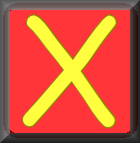
 |
Overdraft ChargesDo you understand how your bank charges you for taking out an overdraft? Try this self marking quiz. |
The daily overdraft fee charged by a major high street bank is different depending on how much you borrow. It could include up to three different amounts added together. Here's how it works:
| Up to £1250 | Between £1250 and £2500 | Over £2500 | ||
| 1pfor every full£6 | + | 1pfor every full£7 | + | 1pfor every full£8 |
 |
This activity is suitable for students of mathematics all around the world. Use the button below to change the currency symbol used to make it more relevant to your students. You may wish to choose an unfamiliar currency to extend your students' experience. |
 |
InstructionsTry your best to answer the questions above. Type your answers into the boxes provided leaving no spaces. As you work through the exercise regularly click the "check" button. If you have any wrong answers, do your best to do corrections but if there is anything you don't understand, please ask your teacher for help. When you have got all of the questions correct you may want to print out this page and paste it into your exercise book. If you keep your work in an ePortfolio you could take a screen shot of your answers and paste that into your Maths file. |
||
|
|
||
|
|

|
More Activities: |
|
Mathematicians are not the people who find Maths easy; they are the people who enjoy how mystifying, puzzling and hard it is. Are you a mathematician? Comment recorded on the 9 April 'Starter of the Day' page by Jan, South Canterbury: "Thank you for sharing such a great resource. I was about to try and get together a bank of starters but time is always required elsewhere, so thank you." Comment recorded on the i asp?ID_Top 'Starter of the Day' page by Ros, Belize: "A really awesome website! Teachers and students are learning in such a fun way! Keep it up..." |
Each month a newsletter is published containing details of the new additions to the Transum website and a new puzzle of the month. The newsletter is then duplicated as a podcast which is available on the major delivery networks. You can listen to the podcast while you are commuting, exercising or relaxing. Transum breaking news is available on Twitter @Transum and if that's not enough there is also a Transum Facebook page. |
|
AnswersThere are answers to this exercise but they are available in this space to teachers, tutors and parents who have logged in to their Transum subscription on this computer. A Transum subscription unlocks the answers to the online exercises, quizzes and puzzles. It also provides the teacher with access to quality external links on each of the Transum Topic pages and the facility to add to the collection themselves. Subscribers can manage class lists, lesson plans and assessment data in the Class Admin application and have access to reports of the Transum Trophies earned by class members. If you would like to enjoy ad-free access to the thousands of Transum resources, receive our monthly newsletter, unlock the printable worksheets and see our Maths Lesson Finishers then sign up for a subscription now: Subscribe |
||
Go MathsLearning and understanding Mathematics, at every level, requires learner engagement. Mathematics is not a spectator sport. Sometimes traditional teaching fails to actively involve students. One way to address the problem is through the use of interactive activities and this web site provides many of those. The Go Maths page is an alphabetical list of free activities designed for students in Secondary/High school. Maths MapAre you looking for something specific? An exercise to supplement the topic you are studying at school at the moment perhaps. Navigate using our Maths Map to find exercises, puzzles and Maths lesson starters grouped by topic. | ||
Teachers | ||
|
If you found this activity useful don't forget to record it in your scheme of work or learning management system. The short URL, ready to be copied and pasted, is as follows: |
Alternatively, if you use Google Classroom, all you have to do is click on the green icon below in order to add this activity to one of your classes. |
It may be worth remembering that if Transum.org should go offline for whatever reason, there is a mirror site at Transum.info that contains most of the resources that are available here on Transum.org. When planning to use technology in your lesson always have a plan B! |
|
|
||
© Transum Mathematics :: This activity can be found online at:
www.Transum.org/go/?Num=786
Close

Level 1 - Calculating the charges given the size of the overdraft
Level 2 - Problem solving questions about bank overdrafts
Flow Chart Bills - This is a simpler exercise in calculating bills given a flowchart.
Exam Style Questions - A collection of problems in the style of GCSE or IB/A-level exam paper questions (worked solutions are available for Transum subscribers).
More on this topic including lesson Starters, visual aids, investigations and self-marking exercises.
Answers to this exercise are available lower down this page when you are logged in to your Transum account. If you don’t yet have a Transum subscription one can be very quickly set up if you are a teacher, tutor or parent.
See the National Curriculum page for links to related online activities and resources.
Overdrafts are a short-term way to borrow money up to an arranged limit. They are one of the most expensive ways of borrowing money so should be avoided it at all possible.
If you borrow £500: £500 at 1p for every full £6 (divide 500 by 6 and round down to the nearest whole number) which is 83p
If you borrow £1,600: First £1,250 at 1p for every full £6 which is £2.08; Plus, £350 at 1p for every full £7 which is £0.50 = Daily fee of £2.58.
If you borrow £3,200: First £1,250 at 1p for every full £6 which is £2.08; Plus, £1,250 at 1p for every full £7 which is £1.78; Plus, £700 at 1p for every full £8 which is £0.87 = Daily fee of £4.73.
If an amount is not a whole number of pounds it should be written with two digits after the decimal point.
This system of calculating overdraft charges was introduced by Lloyds Bank UK on 28 January 2018.
If you borrow £200: There will ne no charge.
If you borrow £1000: The first £250 will be free but the rest, £750 will be charged at the rate of 16%. 750 multiplied by 0.16 = £120.
If you borrow £3000: The first £250 will be free but the next £1750 will be charged at the rate of 16% then the last £1000 will be charged at the rate of 12%. 1750 multiplied by 0.16 + 1000 multiplied by 0.12 = £400.
If an amount is not a whole number of pounds it should be written with two digits after the decimal point.
Don't wait until you have finished the exercise before you click on the 'Check' button. Click it often as you work through the questions to see if you are answering them correctly. You can double-click the 'Check' button to make it float at the bottom of your screen.
Answers to this exercise are available lower down this page when you are logged in to your Transum account. If you don’t yet have a Transum subscription one can be very quickly set up if you are a teacher, tutor or parent.
Close
